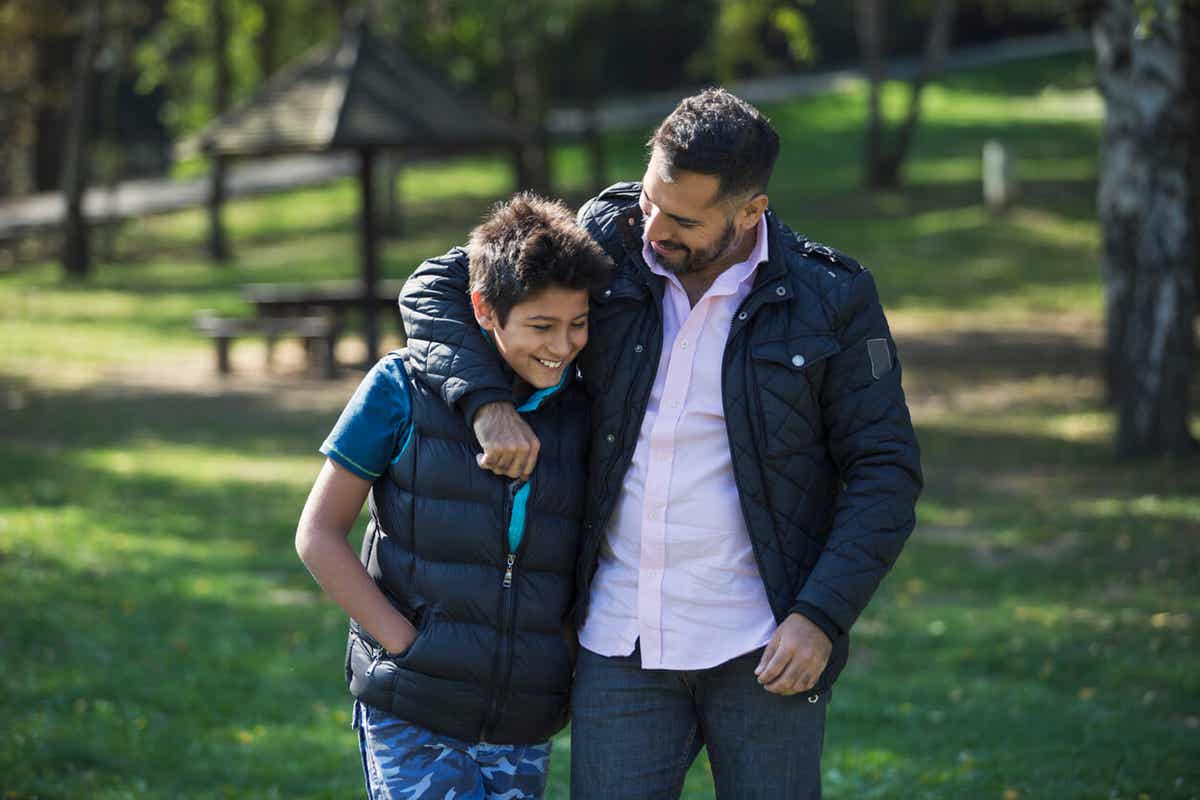5 Ways to Boost Confidence and Avoid Anxiety in Teens


Written and verified by the psychologist Mara Amor López
Today’s kids are under more pressure than their parents were due to the existence of social medial and how tremendously demanding today’s world has become. Therefore, to help as much as possible, we’re going to explain 5 ways to boost confidence and avoid anxiety in adolescents.
As adults, when we think of our childhood times in school, one of the first things we remember is our relationships and social experiences with other classmates and friends from those times. And when our teens reach high school, we can see them going through everything that we went through ourselves: Insecurities, fears, new relationships, and friends, trying to fit in with others, worries, etc.
Tools to boost confidence and avoid anxiety in teens
In order for our children to face life and its adversities more effectively, having great confidence in themselves is crucial. We have to make them aware that we all have strengths that will help develop self-confidence. The tools that we’re going to talk about next will help adolescents gain the confidence they need to move from adolescence to adulthood.

Strengths
According to Dr. Martin Seligman, each person has 24 key strengths within them, such as leadership, humility, or perseverance. We all have them, although some have more and others have less. If we discover our teens’ strengths and get them to use them in their own favor, we’ll make their self-esteem grow. By knowing what they are, they’ll be able to be more certain regarding the paths they’re taking in life.
Emotions
Feelings and emotions are something that we need to be aware of and pay attention to when we communicate with our teens. They aren’t there just to make us feel bad or suffer. Worry, anger, sadness, negativity, and other emotions all try to send us very important messages.
For example, anger can mean that a situation or a person is overstepping our boundaries. Worry can be a sign that something important is about to happen and we need to focus on fixing it or dealing with it. We have to understand why we have a certain feeling when it pops up.
Self-compassion
Sometimes, when a teen feels like they’re being judged or made fun of, it can further increase their self-doubt. To avoid this, you have to practice self-compassion. It has 3 fundamental components:
- Mindfulness: Giving yourself time to feel and understand your own existence.
- Tolerance toward oneself: Talking to yourself in the same way that you would talk to a friend.
- Altruism: Being aware that no one’s perfect and that we are never alone.
These 3 components can help teens, or even younger children, cope with difficult social and emotional situations.
Self-esteem to boost confidence and avoid anxiety
Self-esteem is very important when relating to other people. Depending on whether it’s low or high, we will be more or less likely to interact with other people.
Teens are at a stage in their lives where social relationships are very important and having good self-esteem is going to be key to this. Additionally, it’s important that we value our child’s every effort and make sure they know it. Therefore, whatever criticism we make must be constructive, and we need to help them do what they enjoy. And, of course, we need to dedicate time to them. All of this will help them develop good self-esteem so they can better relate to the rest of the world.
Nervousness
Did you know that nervousness can help us improve our performance? When our nerves take hold of us, they make us more alert and make our blood flow better.

Contrary to what many think, nervousness is more like a feeling of excitement than something unpleasant. As our hearts race, our thoughts go a thousand miles an hour, and we can feel a tingling in our stomachs. So, if teens change their perspective and think that they’re excited rather than nervous, all of this can actually work in their favor.
Conclusion on tips to boost confidence and avoid anxiety in teens
With the tips that we’ve just shown you, you can help boost confidence and avoid anxiety in teens when it comes to meeting new people or being in new environments. They’re the foundation that they have to use to cope with the world outside of their home.
We all know that adolescence is full of changes, both physical and psychological. For this reason, it’s important to take these tools into account when helping your children to trust themselves. Plus, all of this will help boost their confidence as they go from teens to adults.
Today’s kids are under more pressure than their parents were due to the existence of social medial and how tremendously demanding today’s world has become. Therefore, to help as much as possible, we’re going to explain 5 ways to boost confidence and avoid anxiety in adolescents.
As adults, when we think of our childhood times in school, one of the first things we remember is our relationships and social experiences with other classmates and friends from those times. And when our teens reach high school, we can see them going through everything that we went through ourselves: Insecurities, fears, new relationships, and friends, trying to fit in with others, worries, etc.
Tools to boost confidence and avoid anxiety in teens
In order for our children to face life and its adversities more effectively, having great confidence in themselves is crucial. We have to make them aware that we all have strengths that will help develop self-confidence. The tools that we’re going to talk about next will help adolescents gain the confidence they need to move from adolescence to adulthood.

Strengths
According to Dr. Martin Seligman, each person has 24 key strengths within them, such as leadership, humility, or perseverance. We all have them, although some have more and others have less. If we discover our teens’ strengths and get them to use them in their own favor, we’ll make their self-esteem grow. By knowing what they are, they’ll be able to be more certain regarding the paths they’re taking in life.
Emotions
Feelings and emotions are something that we need to be aware of and pay attention to when we communicate with our teens. They aren’t there just to make us feel bad or suffer. Worry, anger, sadness, negativity, and other emotions all try to send us very important messages.
For example, anger can mean that a situation or a person is overstepping our boundaries. Worry can be a sign that something important is about to happen and we need to focus on fixing it or dealing with it. We have to understand why we have a certain feeling when it pops up.
Self-compassion
Sometimes, when a teen feels like they’re being judged or made fun of, it can further increase their self-doubt. To avoid this, you have to practice self-compassion. It has 3 fundamental components:
- Mindfulness: Giving yourself time to feel and understand your own existence.
- Tolerance toward oneself: Talking to yourself in the same way that you would talk to a friend.
- Altruism: Being aware that no one’s perfect and that we are never alone.
These 3 components can help teens, or even younger children, cope with difficult social and emotional situations.
Self-esteem to boost confidence and avoid anxiety
Self-esteem is very important when relating to other people. Depending on whether it’s low or high, we will be more or less likely to interact with other people.
Teens are at a stage in their lives where social relationships are very important and having good self-esteem is going to be key to this. Additionally, it’s important that we value our child’s every effort and make sure they know it. Therefore, whatever criticism we make must be constructive, and we need to help them do what they enjoy. And, of course, we need to dedicate time to them. All of this will help them develop good self-esteem so they can better relate to the rest of the world.
Nervousness
Did you know that nervousness can help us improve our performance? When our nerves take hold of us, they make us more alert and make our blood flow better.

Contrary to what many think, nervousness is more like a feeling of excitement than something unpleasant. As our hearts race, our thoughts go a thousand miles an hour, and we can feel a tingling in our stomachs. So, if teens change their perspective and think that they’re excited rather than nervous, all of this can actually work in their favor.
Conclusion on tips to boost confidence and avoid anxiety in teens
With the tips that we’ve just shown you, you can help boost confidence and avoid anxiety in teens when it comes to meeting new people or being in new environments. They’re the foundation that they have to use to cope with the world outside of their home.
We all know that adolescence is full of changes, both physical and psychological. For this reason, it’s important to take these tools into account when helping your children to trust themselves. Plus, all of this will help boost their confidence as they go from teens to adults.
All cited sources were thoroughly reviewed by our team to ensure their quality, reliability, currency, and validity. The bibliography of this article was considered reliable and of academic or scientific accuracy.
- Massa, J. L. P., & Álvarez, L. M. (2000). Desarrollo psicosocial de la adolescencia: bases para una comprensión actualizada. Documentación social, 120, 69-90. https://d1wqtxts1xzle7.cloudfront.net/46487404/04_BASES_PARA_UNA_COMPRENSION_ACTUALIZADA_DS0120-with-cover-page.pdf?Expires=1623251528&Signature=T56JcA7xbrAPak2f3rJJMuw6VLh2JXoVhwZeiM4CoOuEH2BhKyxgizH3P8CNQoikYumZB9V2FjLNkvAw05AmbfEls3jKLpUsnYNrPFbAxNAQF7FfX74w0ZQ3-J2VhMwqKJqpg5fq8~wk1gRb5iPuWfSUy83foedS4Zl~WJ1FFzGmFEnfdmrB4dhFu5270okzs2LtB9NPKFvOs3~MUz~2ednuPfa8U9Fxj5FWpGP1cfALS93fY9WHvKzwiW-U-QmDpoQwWS7SVxSfvGFDsUjSmw3uDKN06x8BzaJ~bN1BLIDRCtQNN15LxUz75qE3rkwzkN60t8tX9KlFyh8Reg26aw__&Key-Pair-Id=APKAJLOHF5GGSLRBV4ZA
- Santos, C. D., & Vallín, L. S. (2018). La ansiedad en la adolescencia. RqR Enfermería Comunitaria, 6(1), 21-31. https://dialnet.unirioja.es/servlet/articulo?codigo=6317303
- Vázquez, I. N., & Pérez, R. C. (2016). La ansiedad como variable predictora de la autoestima en adolescentes y su influencia en el proceso educativo y en la comunicación. Revista Ibero-americana de Educación, 71(2), 109-128. https://www.researchgate.net/profile/Isabel-Nunez-Vazquez/publication/330913544_La_ansiedad_como_variable_predictora_de_la_autoestima_en_adolescentes_y_su_influencia_en_el_proceso_educativo_y_en_la_comunicacion/links/5f0d734a299bf15bd70b1926/La-ansiedad-como-variable-predictora-de-la-autoestima-en-adolescentes-y-su-influencia-en-el-proceso-educativo-y-en-la-comunicacion.pdf
- Peterson, C., & Seligman, M. E. (2004). Character strengths and virtues: A handbook and classification (Vol. 1). Oxford University Press.
This text is provided for informational purposes only and does not replace consultation with a professional. If in doubt, consult your specialist.








